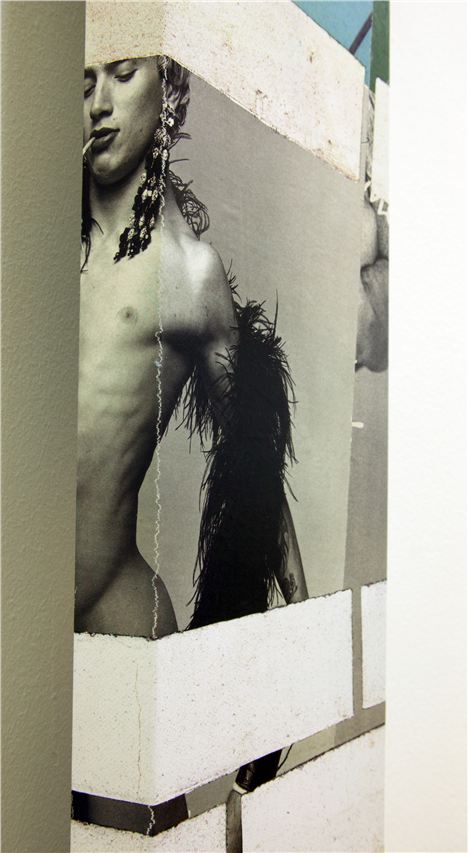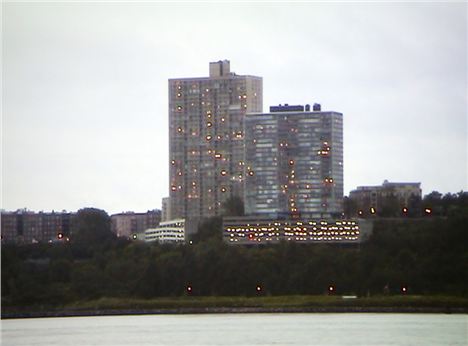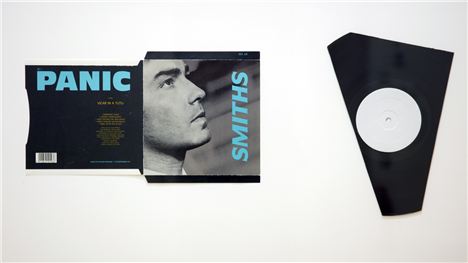CURATED in partnership with DJ Dave Haslam, a new exhibition of work by international contemporary artists Cyprien Gaillard and Kelley Walker studies the effects of post-industrialism and failed utopianism on popular culture.
In this exhibition Morrissey is a symbol of the effects of post-industrialism on popular culture
Neither artist is from Manchester. Walker, who lives and works in New York, has never visited the city.
However, it is easy to spot the parallels between Manchester's modernist architecture and the brutalist tower blocks of the New Jersey shoreline in Gaillard's short film 'The Smithsons', 2005. The highlight of the exhibition, 'The Smithsons' depicts sixties high-rise towers filmed at dusk, which seem to rise out of – or fall into – the dense woodland which surrounds them. The piece examines man's relationship with nature and the effects of nature on human construction – both key themes in Gaillard's work.
Accompanied by The Smiths' single, 'Asleep', there is almost a feeling of regret about the film. Its name refers in part to Alison and Peter Smithson, who coined the term “Brutalist” in 1953. They, and many other architects, saw the movement as a utopian opportunity for equality and honesty, but by the 1970s and 80s it became symbolic of a failing economy and increasing levels of unemployment. The uncompromising view of New Jersey in 'The Smithsons' could easily be a residential area of Manchester.
Dave Haslam has said about the exhibition:
“In the late 1970s, in Manchester's landscape of empty warehouses, derelict factories and high-rise housing, there was a sense of alienation and uncertainty. This trauma was something felt in other cities round the world, but Manchester's post-punk soundtracked it in a particularly potent way.”
The tower blocks in 'The Smithsons' are echoed by Kelley Walker's canvases, on which are collaged pages from Andy Warhol's 'Interview' magazine in a brick pattern. Each is the height of Walker standing on a brick. This reference to the artist's presence highlights his absence, creating a sense of dereliction. We are left facing remnants of popular culture, magazine pages, and ourselves, distorted in the reflection of Walker's sculpture 'LZW'.
Also featured in his installation is an opened out sleeve of The Smiths' single 'Panic' with the record cut up next to it, tying in the Manchester theme once again. The B-side, 'Vicar In A Tutu' features the lyric “I am a living sign”, and it would seem that in this exhibition Morrissey is a symbol of the effects of post-industrialism on popular culture.
Walker's series of screen prints, 'Andy Warhol Doesn't Play Second Base For The Chicago Cubs' and a reflective metal cylinder in the centre of the gallery floor, named 'LZW' after a data compression algorithm, refer to marketing and advertising which have become integral parts of the music industry.
A 1980s copy of The Sun shows the headline: “I'd shoot my son if he had AIDS, says vicar!”. Nostalgia is inherent in the study of failed architectural idealism, and the brick canvases by Walker feature magazine pages dating from 1969 to 2011.
Aside from the references to its music, Manchester is rarely explicitly referred to, yet something of the spirit of the city is implied. Therefore the poignancy of 'Dreams Without Frontiers' seems not to be confined to a Mancunian audience; its ideas and themes are universal.
The exhibition is on display on the ground floor, Manchester Art Gallery, Mosley Street until May 2013. Entry is free. Web
What's happening at Manchester Art Gallery? The Director responds to Jonathan Schofield.
Confidential has been getting complaints.
Readers, and other city commentators, are worried about the artistic and curatorial direction of the Gallery.
Under Maria Balshaw, who also runs the Whitworth Art Galllery, we've had people asking if Manchester Art Gallery is in danger of losing identity and not showing off enough of the permanent collection. For example the twentieth century galleries have disappeared as other works take over on a temporary basis.
Meanwhile the Manchester Gallery - more a local history space but still a wonderful resource for tourists - now houses the two Haslam curated spaces described by William Robinson above.
"The historic collections have to sit with the new," says Balshaw in reply. "I want to do the best with the collections we've got. With the Manchester Gallery we're going to be putting the works that were there out through the galleries so that visitors see them in a new light in relation to other works and artefacts from other periods. It's about balance I agree, but I can assure people the big hitters will remain. The favourites aren't going away.
"This summer we've been unbalanced I concede," Balshaw says. "We've had the We Face Forward exhibition which was our really huge gesture welcoming West African art in Olympic year. We wanted that to be really special. Things will settle down with the New Contemporaries gallery and the exhibitions of the works of Hogarth and Holbein coming along. Galleries can't stand still. We have to keep providing interest and innovation, we have to keep them fresh so they appeal to fresh audiences without alienating the regulars."
She's right about that and she's right about balance, but in Manchester Art Gallery that's a difficult thing to achieve. It's a different space from the Whitworth Art Gallery which Maria Balshaw also directs. As the formal (some might say traditional) gallery many people expect to see the famous names visit after visit and so will many tourists.
You could draw a parallel of a fan going to a gig. The fans want and expect to sing-a-long with the anthems rather than concentrate hard on a new experimental album.
These are still early days for Maria Balshaw at Manchester Art Gallery and ones distorted, as she says, by Olympic year.
In eight months or so we'll have a better idea of her tenure and whether she has found the right balance between satisfying the regular visitor and the casual tourist while also providing the brave innovations that are her hallmark.
 Kelley Walker. Detail from 'Andy Warhol Doesn't Play Second Base For The Chicago Cubs'
Kelley Walker. Detail from 'Andy Warhol Doesn't Play Second Base For The Chicago Cubs'
















